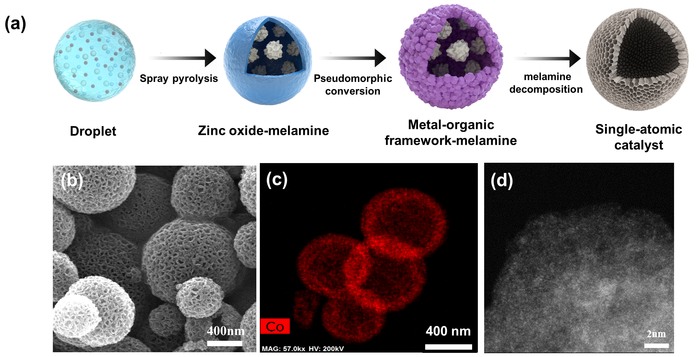FCEVs or Fuel Cell Electric Vehicles are an environmentally beneficial mode of transportation that will eventually replace internal combustion vehicles.
 (a) single-atomic catalyst synthesis process using humidifier method, (b) SEM image, (c) cobalt element mapping image, (d) high-resolution STEM image of cobalt single-atomic catalyst. Image Credit: Korea Institute of Science and Technology (KIST).
(a) single-atomic catalyst synthesis process using humidifier method, (b) SEM image, (c) cobalt element mapping image, (d) high-resolution STEM image of cobalt single-atomic catalyst. Image Credit: Korea Institute of Science and Technology (KIST).
FCEVs have various advantages, including quick charging and extended mileage. However, the high cost of platinum, which is used as a fuel cell catalyst, limits the supply of FCEVs.
Although substantial research has been conducted on non-precious metal catalysts such as iron and cobalt to replace platinum, identifying alternatives for platinum continues to be difficult due to the low performance and stability of non-precious metal catalysts.
Dr. Sung Jong Yoo of the Korea Institute of Science and Technology’s (KIST, President Seok Jin Yoon) Hydrogen Fuel Cell Research Center conducted the joint research with professor Jinsoo Kim of Kyung Hee University and professor Hyung-Kyu Lim of Kangwon National University, and announced the development of a single atomic cobalt-based catalyst with approximately 40% better performance and stability than current cobalt nascent catalysts.
Traditional catalysts are made by pyrolysis, which involves mixing transition metal precursors with carbon at 700–1000 °C. The catalysts generated by this technique have limited activity due to metal aggregation and a poor specific surface area. As a result, researchers have concentrated on synthesizing single-atomic catalysts.
However, previously reported single-atomic catalysts can only be generated in tiny numbers due to the chemical compounds and synthesis methods utilized differing based on the kind of created catalyst. As a result, research has concentrated on improving the catalyst’s performance rather than the production method.
The spray pyrolysis approach was used with an industrial humidifier to solve this problem. Droplet-shaped particles were created by quickly heating droplets collected from a humidifier.
Any metals can be easily manufactured into particles, and mass manufacturing can be done continuously. Since metal particles are generated in an industrial humidifier, the components employed in their synthesis should be water-soluble.
The cobalt-based single-atomic catalysts generated using this approach have been verified to have good stability and fuel cell performance and are 40% better than traditional cobalt catalysts.
In fuel cells, cobalt-based catalysts also generate side reactions; however, computational research has demonstrated that catalysts made by spray pyrolysis cause forward reactions.
Through this research, a process that can enable considerable improvement in the mass production of cobalt-based single-atomic catalysts has been developed, and the operating mechanism of cobalt-based catalysts has been elucidated via close analyses and computational science. These results are expected to serve as indicators for future research on cobalt catalysts.
Dr Sung Jong Yoo, Hydrogen Fuel Cell Research Center, Korea Institute of Science and Technology
Dr Yoo added, “We plan to expand the scope of future research to explore not only catalysts for fuel cells, but also environmental catalysts, water electrolysis, and battery fields.”
The KIST Institutional Program, Climate Change Technology Development Project NanoMaterial Technology Development Project, and the Ministry of Science and ICT supported this study. The findings were published in Applied Catalysis B: Environmental (IF: 19.503 JCR top 0.926%), an international publication on the subject of energy and the environment.
Journal Reference:
Im, K., et al. (2022) Design of Co-NC as efficient electrocatalyst: The unique structure and active site for remarkable durability of proton exchange membrane fuel cells. apcatb doi:10.1016/j.apcatb.2022.121220.